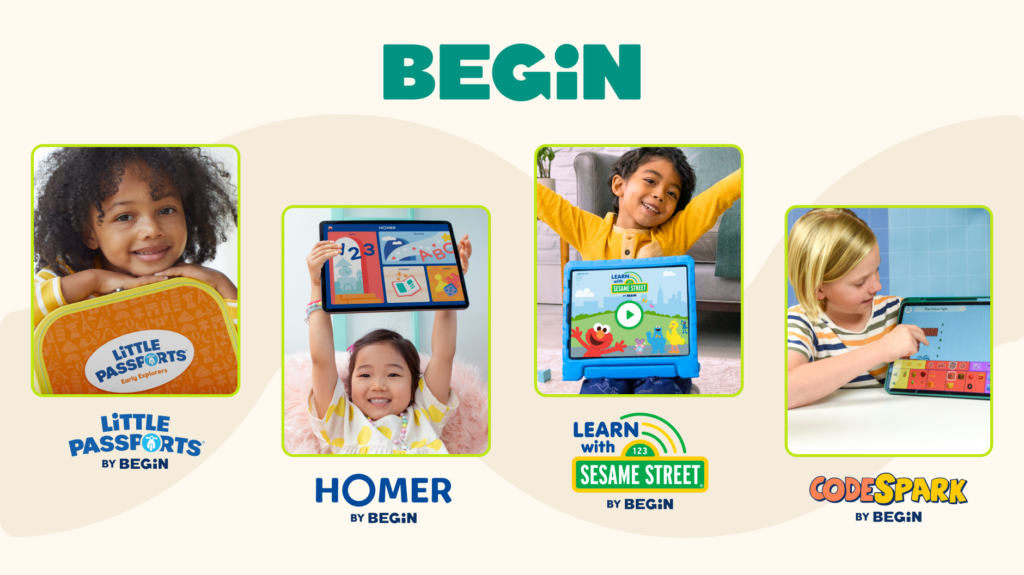Tantrums are like fireworks. Sometimes they’re one large BANG and sometimes a whole bunch of little ones. And they’re loud. Really loud.
Unlike fireworks, they’re not so fun. But they’re common, especially in kids between 1 and 3 years old.
At that age, kids are just beginning to develop social and emotional skills, so they often aren’t able to communicate what they need and how they feel. They also get frustrated easily. This combination leads to tantrums!
And even when kids get past that stage, occasional tantrums are normal as they build resilience and the ability to manage their own feelings.
How can you help your child understand and manage their temper tantrums? How can you guide them toward self-regulation and emotional intelligence? We have seven steps to try!
The Short Cut
- Learning how to deal with intense emotions like temper tantrums helps build Character, one of the 5 C’s at the heart of the Begin Approach to helping kids thrive in school and life
- Teaching your child effective emotional coping skills while they’re young prepares them for grown-up challenges later in life
- Calming techniques, learning what triggers tantrums in your child, and helping them solve their problems all reduce temper tantrums
- A play-based learning membership that grows with your child can also help them learn to deal with temper tantrums
What Are Temper Tantrums Anyway?

When you think of temper tantrums, you may think of yelling, screaming, crying, throwing things, falling to the ground, and other loud, emotionally charged actions. Tantrums look like these things. But that’s not all they are.
Temper tantrums are actually a reaction to something else that your child doesn’t know how to handle. Instead of articulating what they feel or asking for what they want or accepting what they need to do, they get overwhelmed and act out—loudly, dramatically, emotionally, and (often) physically.
Addressing the “something else” your child is reacting to is the biggest key to overcoming temper tantrums.
7 Steps to Work Through Temper Tantrums
So how can you best manage your child’s temper tantrums? How can you cope with their meltdowns before, during, and after the event? Try these seven steps.
1. Pay Attention to What Happens Before
Before you can effectively help your child get through a temper tantrum, you need to know what triggered it. For instance, you’ll handle a tantrum about going to bed sparked by a fear of the dark differently than one set off by being overly tired.
If your child has lots of temper tantrums, pay close attention to the situations in which they occur. Do you notice any recurring triggers? Once they’ve calmed down, can your child identify a deeper reason they were upset (“I didn’t want the light off because I was scared a bug would get me.”)? Can you begin to anticipate what will be hard for them?
Gathering information like this helps you stop the cycle of tantrums.
2. Anticipate the Trigger

Once you find out what sets off your child’s temper tantrum, you can assess it and make decisions accordingly.
Say your child is prone to tantrums when you have to wake them from a nap to take them somewhere—maybe to go to the grocery store or pick up their older sibling from school.
If you’ve got flexibility in the order you do things, you could do the grocery shopping before they go down for their nap. Or you might try to help your child go to sleep earlier or wake them up a little bit earlier so they have time to transition.
Even small changes can defuse the trigger just enough to make a difference. And if you can’t defuse the trigger, anticipating the tantrum and preparing for it mentally and logistically (by leaving extra time, for example), can make it much easier on you both.
3. Ignore the Tantrum & Embrace the Effort
Once your child begins a tantrum (and once you know they’re physically safe while they’re engaged in it) the best thing you can do is nothing.
The less attention you place on their out-of-control behavior, either positive or negative, the less they will engage in it. When your child is having a tantrum, they want two things: to change the thing that initiated the outburst (to stay at the playground, stay up at bedtime, get a toy at the store, etc.) and your focus.
If you can disengage completely, your child has an opportunity (after the tantrum winds down) to try a new approach to handling their emotions. They might ask for your attention. Or apologize. If they’re unsure of what to do next, you might try asking them some questions: “Are you feeling better? Do you want to talk? Do you know what you were just feeling?”
As soon as they reach out in an appropriate way, your attention and interest become very valuable. By engaging with them once they’ve calmed down, you’re teaching your child that calming down, figuring out a solution to the problem, and letting go of their anger are the best ways to connect and communicate with you.
4. Don’t Reason with the Rant
Wait to reason with your child until they’re able to listen and think calmly. If they’re in the middle of a temper tantrum, they’re not available. It often feels like they’re on a ride that they can’t get off. (For you and for them!)
And the truth is, it’s often hard for us as parents to be thoughtful and calm in the midst of a child’s tantrum too. So it’s helpful for everyone to wait.
5. Teach Your Child How to Self-Soothe

The best way to help your child learn how to avoid or shorten their temper tantrums is by modeling calm, centered behavior.
When you get frustrated, scared, angry, or anxious, how do you act? If your child watches you take a break, take a walk, or do some intentional breathing exercises, they are more likely to do the same.
Sometimes it looks a little different when kids do it. Your 4-year-old may stomp angrily off to their room screaming “I need some space!” and slam the door instead of saying, “I’m getting very frustrated. I need a few minutes by myself to calm down. I’ll be right back,” like you do. But it’s still progress!
By imitating you, they begin to understand what calming down feels like—and once they have that visceral awareness, they can practice it.
6. Give Your Kid Some Control

Although you can’t let your child decide that yes, you’ll buy that box of cookies and yes, they can stay up late, and yes, they can play whatever video games they want for as long as they want, you can be intentional about giving them control when it’s appropriate.
Give them the opportunity to make choices and decisions throughout the day. You can even make them a part of your rituals. “Do you want to wear the blue shirt or the gray one?” “Would you like yogurt or eggs for breakfast?” “Pick any book you want for our bedtime reading.”
You can also be spontaneous about accepting their proposals when it feels healthy and appropriate. “I bet you’re thirsty after playing soccer. Sure, you can have some juice.” “You’ve been so patient while we ran those errands. Yes, you can choose an episode of Sesame Street for us to watch together even though this isn’t our normal screen time.” “I’m hearing that you want to read a fourth book tonight. We have some extra time, so go ahead and pick one out.”
Feeling empowered in these small ways throughout the day can fill your child with a confidence and comfort that may reduce temper tantrums when they have to let go of decision-making control.
7. Engage Mid-Tantrum
Sometimes (but not every time—you’re not doing anything wrong if it doesn’t always work!) it’s possible to interrupt a tantrum as it’s unfolding. A few ways to try:
- Empathize with how your child is feeling. Sometimes being seen and understood is all they need. Saying something like “It looks like you’re sad about leaving the park. I understand how hard that must feel” might be all it takes for your child to find calm.
- Troubleshoot in the moment. You might be able to stop a tantrum midstream if you have a good guess as to why it’s happening. If your child is hungry, for example, offering them a snack might help them recover more quickly.
- Create an equal and appealing distraction. If your child is melting down in the grocery store, you could suggest telling a story as you shop. Maybe you’ll tell one to them, or they can tell one to you, or you can make one up together!
- A specific idea suggested by the UK nonprofit National Society for the Prevention of Cruelty to Children is to try a 5-4-3-2-1 activity. Ask them to name:
- 5 things they can see
- 4 things they can touch
- 3 things that are red
- 2 things you could taste
- 1 thing that is noisy (which means they have to stop making noise to find it!)
Managing Temper Tantrums at Different Ages

Like most aspects of raising a child, there is no manual or set of guidelines to make temper tantrums predictable. But according to the American Academy of Child and Adolescent Psychiatry, childhood tantrums generally follow this trajectory:
Toddlers (18 months to 2 years old)
Tantrums are very common at these ages. Kids have them in a variety of ways: screaming, crying, hitting, kicking, or throwing themselves on the ground. It isn’t unusual for tantrums to occur every day.
Preschoolers (3 to 5 years old)
Although temper tantrums are still common at these ages, they aren’t happening as often anymore.
School-Age Kids (6 to 13 years old)
Temper tantrums become much less common, most likely occurring less than once a week. If they are routinely happening or are very intense, you may want to reach out to your doctor or a mental health professional who can help you determine what your child needs and how to support them.
Are Tantrums on Purpose?
Many parents wonder whether tantrums happen on purpose. There’s a good reason for that, because the answer is no at first—but possibly yes later.
Tantrums aren’t conscious at first. Your child feels strongly about something—they’re frustrated, scared, angry, or anxious—and they don’t know how to express it in a nuanced and constructive way. The emotion is inside them and they need to express it. So they aren’t being willful and they aren’t acting according to some plan they’ve created.
But if your child throws a tantrum and gets what they want over and over again, then, yes, these bursts of disruptive behavior can become intentional. Kids can learn tantrums are an effective way of getting their needs and wants met.
Our challenge as parents is to help our children find healthy ways to satisfy those needs and wants, as well as healthy ways to cope when they can’t be satisfied.
The first and most important step is to resist giving them what they want when they have a tantrum. If they’re in a safe place and aren’t hurting themselves or others, ignoring their outburst is key. Even negative attention gives them the incentive to continue.
Once they’ve calmed down, or even tried to calm down, give them your focus. None of this is easy, but it’s totally doable—and worth it!
How Developing Emotional Intelligence Helps with Tantrums
Emotional intelligence, at its core, is the ability to identify and manage your own emotions as well as the emotions of others. In a lot of ways, it is on the opposite side of the emotional spectrum from temper tantrums.
Your child hasn’t fully cultivated their emotional intelligence. They’ll be working on self-awareness, self-regulation, empathy, and social skills for years. But the more you talk with your child about their feelings, why they experience them, and how to manage them, the faster those skills will grow.
Many of the other ways you can help nurture your child’s emotional intelligence also decrease the likelihood of temper tantrums, including:
- Unstructured play, where they can practice expressing emotions, handling conflict, and solving problems
- Encouraging self-expression alongside a growth mindset, which helps your child find thoughtful ways to handle their feelings
- Doing daily check-ins about your child’s emotions so they learn how to talk about them when they’re calm
- Modeling how to handle big feelings
Stay with It—Begin Has Your Back

There’s no way around it: temper tantrums are tough. They’re tiring, they’re overwhelming, and sometimes (when they’re public) they can be embarrassing for both you and your child.
But they’re normal too. And even though they seem to come out of the blue sometimes, they can give you really good information about how your child operates, what opinions they have, and what triggers their big feelings.
You’re not alone in your journey to figure out how to strategize about temper tantrums. All parents experience them. Don’t hesitate to reach out to some of your friends, family, or neighbors who have traveled ahead of you—or who are right there beside you.
Begin can help you too!
Our age- and stage-matched learning membership is full of resources for both you and your child. From social-emotional learning with Sesame Street friends to hands-on activities to books that reinforce emotional well-being, the membership helps kids learn the social-emotional skills they need to thrive.
Take our quiz to see which stage fits your family today!













